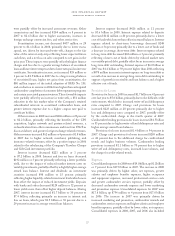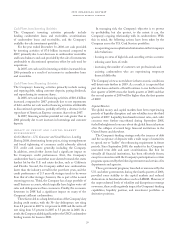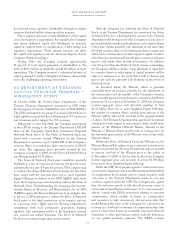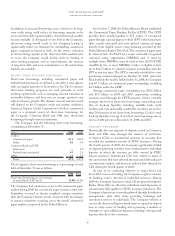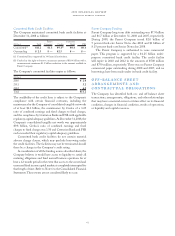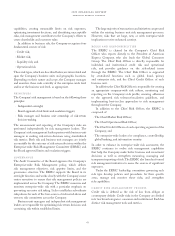American Express 2008 Annual Report Download - page 37
Download and view the complete annual report
Please find page 37 of the 2008 American Express annual report below. You can navigate through the pages in the report by either clicking on the pages listed below, or by using the keyword search tool below to find specific information within the annual report.
2008 financial review
american express company
The Company has historically relied on the debt capital
markets to satisfy a substantial amount of its funding needs,
as do many financial services companies. Notwithstanding the
difficult conditions in the financial markets during the past
year, the Company accessed a variety of capital markets sources
during the first three quarters of the year. The Company’s
issuances of debt securities and securitizations, similar to most
issuances across the capital markets, included spreads above
benchmark rates that were significantly greater than those on
similar issuances completed during the prior several years.
The Company’s strategy is to issue debt and deposits
with a wide range of maturities to reduce and spread out the
refinancing requirements in future periods. However, the
Company’s ability to obtain financing in the debt capital market
for unsecured term debt and asset securitizations is subject to a
renewal of investor demand. The Company continues to assess
its needs and investor demand, which will likely change the
mix of its existing sources as well as seek to add new sources
to its funding mix. The Company’s funding plan is subject to
various risks and uncertainties, such as disruption of financial
markets, market capacity and demand for securities offered by
the Company, regulatory changes, ability to sell receivables and
the performance of receivables previously sold in securitization
transactions. Many of these risks and uncertainties are beyond
the Company’s control.
funding programs and activities
The Company meets its funding needs through a variety of
sources, including debt instruments such as commercial paper,
senior unsecured debentures and asset securitizations, long-
term committed bank borrowing facilities in certain non-U.S.
markets, and deposits placed with the Company’s U.S. banks by
individuals and institutions.
The following discussion includes information on both a
GAAP and managed basis. The managed basis presentation
includes debt issued in connection with the Company’s lending
securitization activities, which are off-balance sheet. For a
discussion of managed basis and management’s rationale for
such presentation, refer to the U.S. Card Services discussion
below. The Company had the following consolidated debt,
on both a GAAP and managed basis, and customer deposits
outstanding at December 31:
(Billions) 2008 2007
Short-term borrowings $ 9.0 $ 17.8
Long-term debt 60.0 55.3
Total debt (GAAP basis) 69.0 73.1
Off-balance sheet securitizations 29.0 22.7
Total debt (managed basis) 98.0 95.8
Customer deposits 15.5 15.4
Total debt (managed) and
customer deposits $113.5 $111.2
The Company’s current funding strategy for 2009 will be to
raise funds to maintain sufficient cash, and readily-marketable
securities that are easily convertible to cash in order to meet
short-term borrowings outstanding, seasonal and other working
capital needs for the next 12 months, including maturing
obligations, changes in receivables and other asset balances, as
well as operating requirements. The Company has $14.9 billion of
unsecured long-term debt and $4.8 billion of asset securitizations
that will mature during 2009. Cash provided by or required for
changes in business volumes will depend in large part on billings
volume and payment patterns from cardmembers. Refer to the
discussion above regarding how the credit market environment
could affect the mix of debt issuances.
The Company’s equity capital and funding strategies
are designed to maintain high and stable debt ratings from
the major credit rating agencies, Moody’s Investor Services
(Moody’s), Standard & Poor’s (S&P), Fitch Ratings, and
Dominion Bond Rating Services (DBRS). Recently, three of
the four credit rating agencies that rate the Company provided
updates on the Company’s ratings as follows:
• Moody’s lowered the Long-term Senior ratings of the
Company from A1 to A2, American Express Travel Related
Services Company, Inc. (TRS) and several rated subsidiaries
from Aa3 to A1 and revised its outlook of the Company and
its subsidiaries from stable to negative. This change, which
brings the ratings for the Company’s funding subsidiaries
to the same level as other rating agencies, reflects concerns
regarding weakness in the broader economy and specific
concerns regarding “negative asset quality trends and
lending exposures.” Moody’s affirmed all of its short-term
ratings. On October 23, 2008, Moody’s affirmed its ratings
on all outstanding classes of rated asset-backed securities
issued by the Company’s lending and charge trusts.
On February 25, 2009, Moody’s placed on review for
possible downgrade the long-term and short-term ratings
of the Company (A2/Prime-1). At the same time, the long-
term debt ratings of TRS and its rated operating subsidiaries
(senior at A1) were also placed on review for possible
downgrade. The Prime-1 short-term ratings for TRS and its
rated operating subsidiaries were affirmed.
• S&P lowered the long-term ratings of the Company, TRS and
several rated subsidiaries from A+ to A. The outlook on the
ratings is negative. S&P’s affirmed its short-term ratings.
• DBRS announced that it had revised its outlook on the
Long-term Senior ratings of the Company and its related
subsidiaries (A (high)) from stable to negative.
Historically, credit ratings have had a significant impact on the
borrowing capacity and costs of the Company. A downgrade
in the Company’s long-term debt rating would result in higher
interest expense on the Company’s unsecured debt, as well as
higher fees related to borrowings under its unused lines of credit.
35




